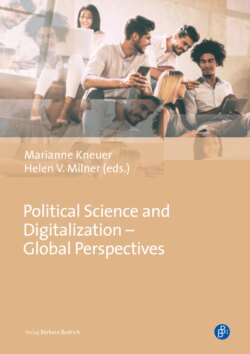Читать книгу Political Science and Digitalization - Global Perspectives - Группа авторов - Страница 29
На сайте Литреса книга снята с продажи.
2.1 Experience on teaching political sciences in a digital revolution
ОглавлениеThe digital revolution is not covered in the political science curricula. Very few professorships have been created, but only for Master’s programs and some optional courses for Ph. D. Programs, mostly related to e-governments.
The UAEMEX started content change and teaching experience by introducing a new undergraduate program called Information Management in Online Social media. The first generation began last August 2017, with 20 students in a mixed e-learning mode. Other universities, like UNAM and the private university ITESM, have developed extracurricular programs in Coursera, OpenEdX and other internal courses focused on open access.
Most students use their smartphones in the classroom every day. The teacher does not know if they are phubbing4 or if students are looking for something related to the topic. Teaching in the 21 century is challenging for the many distractions we face through technology. Social sciences are not an exception. Teachers in Mexico are thinking about how to deal with this situation. There is not a right answer, but a combination of different teaching strategies – i. e., online vs. offline – could help.
At the university, we combine different solutions. The use of a website such as Schoology, is a landing zone for materials, discussions, news, comments and homework activities. The second part of combined digital tools is the use of Prezi. This innovator presentation software changes the perspective of students and creates a more relaxed exposition of contents, different from the common power point slides. Students become more engaged and make questions about the content. Even more, Prezi allows including video, audio, photos and has an extraordinary use of different templates with motion.
The third and last part of the combined digital tools is the use of social media platforms to increase discussions, share links and contents and create the sense of a virtual community. Of course, this should not be done in an invasive way, posting comments every day or at every hour, but in just a balance including news that creates curiosity or interaction about a complex task. The use of Instagram, Twitter or Facebook in class allows some freedom to participate beyond the classroom and enables the teacher to repeat content and to produce some discussions about certain social sciences topics.
[45] These combined digital tools – Website-Prezi-Social media – have practical advantages. Students must develop intellectual skills if they develop their own content, involve a deep investigation about a certain topic and present it online, develop more challenging tasks that include the use of technology, like role-playing strategies for decision making or to understand certain situations of political communication. Complementary strategies such as providing content via Websites to be discussed in class could be enriched with some messages using SNS, specially Facebook – if the class share a web page – or maybe using presentations as Prezi to interact with the online content.
Also, a practical strategy with real problems or in-site discussions of several public policies or actual problems in the governments could help provide a practical perspective of the theories and ideas. Even though, there is no evidence so far to confirm these combined strategies in the case of Mexico’s political science students.
Additional recommendations could help introduce more digital strategies into the classroom of political science students. For example, avoid boring and long readings for college students. Prefer short, concise, but with strong ideas that can remark some points of the lecture and improve the learning, use web sites or direct PDF files to share readings. Complement class sessions with short videos (1–5 min), appealing images and create a different learning environment related to the class topic which will help combine technology with offline discussions and interactions. Constant changes and dynamic lectures are the main issues to focus these distracted students’ attention on the new digital era.
